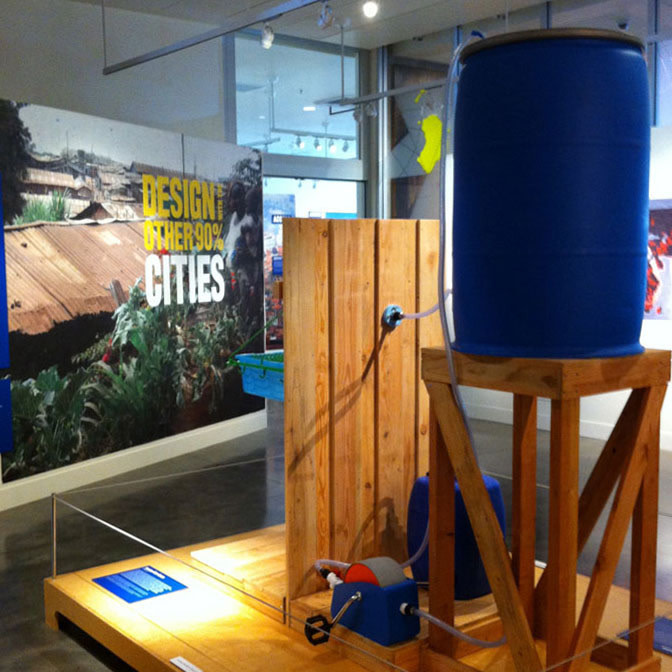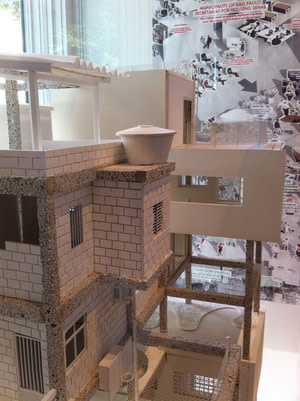Design With the Other 90 Percent

Safe water is hard to provide in dense, quickly built urban settlements (also known as slums). Design With the Other 90% shows simple, innovative solutions to such basic needs.
Image: Kristin Belz
Every city is a laboratory, the site of experiments in living and building, whether we think of them that way or not. Here in Portland we tend to be rather proud, thank you very much, of our ongoing experiments in progressive urban settlement.
We get national media attention (New York Times, Wall Street Journal—again?!). We win awards (Best city for bikes! Best food carts/ice cream/coffee/craft brews!). We proclaim, on our government vehicles, “Portland, the City that Works.”
But beyond our satisfaction with Stumptown, it’s crucial to remember that many other cities are facing far greater challenges, and coming up with smart solutions. The recently opened exhibit Design With the Other 90% is a welcome window into those challenges and some of the innovations occurring outside of deliberately planned, pleased-with-itself Portland.

Architect Mohammed Rezwan designed floating community lifeboats for people living in the flood-prone Ganges-Brahmaputra Delta in Bangladesh, the most densely populated area in the world. If the water rises a mere 19 inches, six million people would lose their homes.
Presented jointly at Mercy Corps and the Museum of Contemporary Craft (in partnership with Pacific Northwest College of Art), the exhibit is a chance to stop seeing ourselves as a “model city” and to “reverse the power structure a little bit, and learn from other areas of the globe,” as MoCC director/head curator Namita Gupta Wiggers puts it. That is a major theme and intent of the show: getting designers not only to design FOR the “other 90 percent” (who don’t usually get the attention of the design world), but also with the other 90 percent. Organized by the Cooper-Hewitt National Design Museum (the design-focused, New York-based branch of the federally-funded Smithsonian), this exhibit follows its 2007 show, Design For the Other 90 Percent. Mercy Corps hosted the first show in 2009-10 when it opened its renovated headquarters in the Skidmore/Old Town neighborhood of downtown. The exhibit attracted some 20,000 visitors.
Since the time of the first exhibit, our awareness of the “other 90 percent” has increased. Today we think a lot about the 99 percent. But while most of us aren’t part of the one percent, we’re also not part of the “other 90 percent” that these exhibits rightfully address.

Columns and beams for the building represented by this model would be made of concrete mixed with recycled urban waste materials gathered by the building’s future residents.
The other 90 percent are the nearly one billion people who live in rapidly forming, temporary, informal urban settlements—places “commonly referred to as slums,” as the exhibit explains. The problems in these urban places are far beyond Portland’s concern with, say, whether or not to put fluoride in the water, or what to do about the 65 miles or so of “unpaved,” gravel-covered city streets. As an educational tour, the new “Design With the Other 90%-CITIES” exhibit should be required viewing. The show will be up through January 5, 2013, so there’s no excuse not to see it. You might need a couple visits to take it all in: it’s bright and eye-catching, yet text-heavy, info-laden and dense, presented without much hierarchy or big picture context.
MoCC director Wiggers sees the inclusion of “a lot of text” as “often necessary” in such an “architecture-oriented installation.” The heavy reading can more easily be done in the book accompanying the exhibit, or on the excellent Cooper-Hewitt website.
Though the exhibit includes maps, architectural models, video, super-sized color photos, and even a soundtrack of city noises, it tends not to summarize projects. Some 60 in all, the projects are grouped by six themes (Exchange, Reveal, Adapt, Include, Prosper, and Access), but these categories seem like an afterthought. It’s easy to forget which theme you’re looking at.
Not that it matters. The point isn’t “exchange” vs. “access,” it’s that these basic needs—food, water, hygiene, shelter, transportation, education, electricity—are vast and complicated problems at this scale of rapid, underfunded (to put it mildly) urbanization.
The most engaging aspects of the show are the full-scale models and physical examples of innovative problem-solving designs. For instance: a cargo bike with components that put in perspective our Portland D.I.Y. pride; reusable plastic formwork for pouring in concrete to make walls; prefabricated columns and beams made of concrete or polymer speckled with recycled urban waste materials.
Both Mercy Corps and MoCC will host several related events in the month of September, especially during Design Week September 9-13. One highlight will be a lecture by Cynthia Smith, the show curator (and Cooper-Hewitt’s Curator of Socially Responsible Design). We’ll update you on these events here and in the At Home blog.
The Design With the Other 90 Percent exhibit is split between two locations:
Mercy Corps Action Center
28 SW First Ave.
503-896-5747
Exhibit hours: Monday–Friday, 11 am–6 pm
Saturday, 11 am–5 pm
Admission: free
Museum of Contemporary Craft
PNCA Museum of Contemporary Craft
724 NW Davis St.
503-223-2654
Exhibit hours:Tuesday–Saturday, 11 am–6 pm
First Thursday, September 6, 11 am–8 pm
Admission: $4 adults, $3 seniors and students; free for 12 and under, and for all on First Thursday of each month)
For more about Portland arts, visit PoMo's Arts & Entertainment Calendar, stream content with an RSS feed, sign up for our weekly On The Town Newsletter, or follow us on Twitter @PoMoArt. Blog content reflects the views of the individual author and not necessarily SagaCity Media, Inc.
